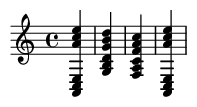Summary:
The i-bVII-bVI progression is a cornerstone of rock harmony, creating a dark, epic, and mysterious atmosphere. Derived from the natural minor scale (Aeolian mode), this sequence avoids traditional major-key resolutions, providing a powerful, cyclical foundation for metal, progressive rock, and alternative music. This article delves into its theory, application, and iconic use in music history.
Keywords:
modal rock, i-bVII-bVI, Aeolian mode, natural minor, music theory, rock guitar, chord progressions, metal harmony, modal interchange
Introduction: What is the i-bVII-bVI Progression?
When you hear a chord progression that sounds heroic yet melancholic, powerful but not necessarily "happy," you may be hearing the i-bVII-bVI. It represents a fundamental shift away from the bright, resolving tendencies of major-key harmony and embraces the darker, ancient sound of the Aeolian mode. Prominent since the 1960s folk revival and later electrified by rock gods, this progression offers a direct path to creating music that feels both timeless and raw.
The Modal Foundation: Aeolian Harmony
This progression is built directly from the chords found in the natural minor scale, also known as the Aeolian mode. Let's use A natural minor (A-B-C-D-E-F-G) as our example. The chords are:
- i: A minor (A-C-E)
- bVII: G major (G-B-D)
- bVI: F major (F-A-C)
The "b" symbols in bVII and bVI indicate that these scale degrees are lowered compared to the major scale (A major has an F# and a G#). This is the standard convention for Roman numeral analysis, but in the context of the natural minor scale, these chords are perfectly diatonic—no "borrowing" is needed. The progression's power comes from its descending root motion (A → G → F), creating a strong, satisfying pull back to the minor tonic without using the dominant V chord (E major) typical of classical harmony.
Basic i-bVII-bVI Progression in A Minor
Here are the fundamental chords played as simple triads. Notice how each chord flows smoothly into the next.

Famous Examples in Rock Music
This progression is everywhere in rock, often forming the backbone of verses or iconic riffs. Its cyclical nature makes it perfect for setting a mood.
Notable Songs Using i-bVII-bVI:
- "All Along the Watchtower" (Jimi Hendrix Experience) : The definitive version uses a variation, Am - G - F - G (i-bVII-bVI-bVII), creating an endless, hypnotic loop that propelled the song to legendary status.
- "Stairway to Heaven" (Led Zeppelin): The famous arpeggiated intro follows a clear Am - G - F - Am (i-bVII-bVI-i) pattern in one of its cycles, setting a mystical, folk-inspired tone.
- "2 Minutes to Midnight" (Iron Maiden): The main riff is a driving, powerful example in E minor: Em - D - C (i-bVII-bVI). This is a textbook use of the progression in heavy metal.
- "The One I Love" (R.E.M.): The raw, emotional chorus is built on a variation: Em - D - C - D (i-bVII-bVI-bVII), showcasing its effectiveness in alternative rock.
Guitar Techniques and Voicings
In rock, the i-bVII-bVI is rarely played with simple, clean triads. Its power is amplified through specific guitar techniques.
Power Chords for a Heavier Sound
Using power chords (root and fifth) removes the third from each chord, creating a harmonically ambiguous and heavy sound that's perfect for distortion. Here's a typical rock rhythm using power chords.

Arpeggiated and Fingerpicked Patterns
For a more atmospheric or folk-like feel, arpeggiating the chords creates texture and movement. This approach is famously used in "Stairway to Heaven."

Improvising Over the Progression
The beauty of this modal progression is that a single scale works perfectly over all the chords. The natural minor (Aeolian) scale is your home base. For our A minor example, you would use the A Natural Minor scale.
- A Natural Minor (Aeolian): A - B - C - D - E - F - G. All the notes in the chords (Am, G, F) are contained within this scale.
- A Minor Pentatonic: A - C - D - E - G. This is a simplified, bluesier-sounding choice that is always effective in a rock context. You can add the F for a "b6" flavor and the B for a "major 2nd" color.
A Natural Minor Scale (A Aeolian)
This is the primary scale choice for improvising melodic lines and solos.

Compositional Applications
The i-bVII-bVI progression is a versatile songwriting tool. Its non-resolving, cyclical nature makes it ideal for setting a mood and letting a vocal melody or lead instrument take the spotlight.
- Verse Foundation: It's perfect for creating introspective or driving verses that build anticipation for a contrasting chorus.
- Instrumental Riffs: Many iconic metal and rock riffs are built on this progression or a slight variation.
- Bridge Material: It can provide a powerful contrast to a song that is primarily in a major key, introducing a moment of darkness or reflection.
- Outros: Its looping quality makes it ideal for powerful, repetitive fade-outs or extended jam sections.
Conclusion: An Essential Piece of the Rock Lexicon
The i-bVII-bVI progression is more than just a sequence of chords; it's a statement. By rejecting the pull of traditional V-I cadences, it establishes a powerful, self-contained minor tonality that has defined the sound of countless rock anthems. Its ability to convey mystery, power, and melancholy with just three chords has made it a favorite tool for songwriters across generations. Understanding how to use it, and how to improvise over it, is an essential skill for any musician looking to master the language of rock.
References:
Stephenson, Ken. (2002) . What to Listen for in Rock: A Stylistic Analysis. Yale University Press.
Moore, Allan F. (2012). Song Means: Analysing and Interpreting Recorded Popular Song. Ashgate Publishing.
Hendrix, Jimi. (1968). All Along the Watchtower. Track Records.
Led Zeppelin. (1971). Stairway to Heaven. Atlantic Records.
Iron Maiden. (1984). 2 Minutes to Midnight. EMI Records.
